Official New Updated 70-433 Exam Questions and Answers Shared By Braindump2go For Free Download Today! (171-180)
The 70-433 Exam Practice Questions and Answers are ideal for the aspring candiates to grab exceptional grades in Microsoft 70-433 Exam! The 70-433 Questions and Answers are developed using the latest updated course content and all the answers are verified to ensure phenoment preparation for the actual 70-433 Exam!
Exam Code: 70-433
Exam Name: TS: Microsoft SQL Server 2008, Database Development
Certification Provider: Microsoft
Keywords: 70-433 Exam Dumps,70-433 Practice Tests,70-433 Practice Exams,70-433 Exam Questions,70-433 PDF,70-433 VCE Free,70-433 Book,70-433 E-Book,70-433 Study Guide,70-433 Braindump,70-433 Prep Guide

QUESTION 171
You are a database developer working on an application hosted on Microsoft SQL Server 2008 R2.
The application regularly imports employee data from XML files.
These files are bulk- loaded into the CompanyDoc column of the CompanyXML table.
The table the following definition:
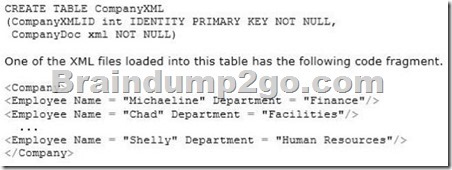
You need to be able to return the data as shown in the following table:

Which Transact-SQL statements should you use?
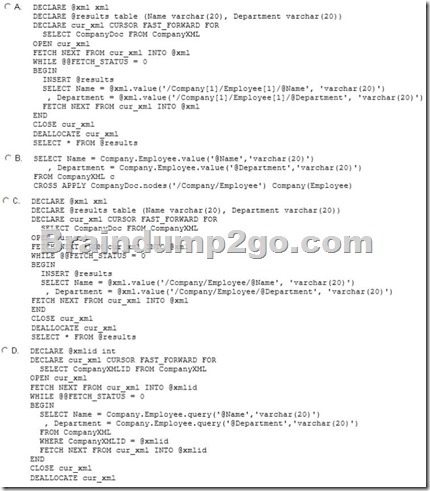
A. Option A
B. Option B
C. Option C
D. Option D
Answer: C
QUESTION 172
You administer a Microsoft SQL Server 2008 database named AdventureWorks that contains a table named Production.Product.
The table contains a primary key named PK_Product_ProductID and a non-clustered index named AK_Product_ProductNumber.
Both indexes have been created on a single primary partition.
The table has the following definition:

You want to ensure that data retrieval takes the minimum amount of time when the queries executed against the Production.Product table are ordered by product number or filtered by class.
You observe that the average fragmentation for the AK_Product_ProductNumber index is 24 percent.
You need to reduce fragmentation.
You need to achieve this goal without blocking access to table data.
Which Transact-SQL statement should you use?
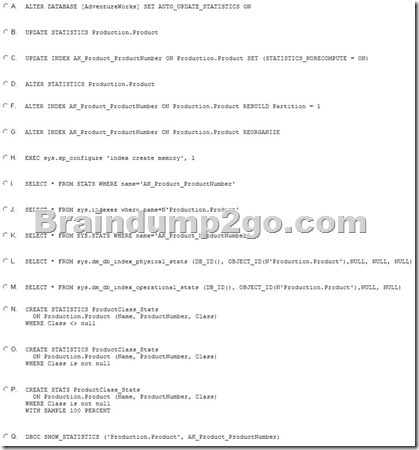
A. Option A
B. Option B
C. Option C
D. Option D
E. Option E
F. Option F
G. Option G
H. Option H
I. Option I
J. Option J
K. Option K
L. Option L
M. Option M
N. Option N
O. Option O
P. Option P
Q. Option Q
Answer: G
QUESTION 173
You administer a Microsoft SQL Server 2008 database named AdventureWorks that contains a table named Production.Product.
The table contains a primary key named PK_Product_ProductID and a non-clustered index named AK_Product_ProductNumber.
Both indexes have been created on a single primary partition.
The table has the following definition:
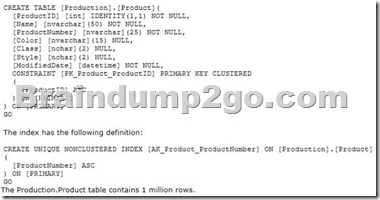
You want to ensure that data retrieval takes the minimum amount of time when the queries executed against the Production.
Product table are ordered by product number or filtered by class.
You need to find out the degree of fragmentation for the indexes on the Production.Product table.
Which Transact-SQL statement should you use?

A. Option A
B. Option B
C. Option C
D. Option D
E. Option E
F. Option F
G. Option G
H. Option H
I. Option I
J. Option J
K. Option K
L. Option L
M. Option M
N. Option N
O. Option O
P. Option P
Q. Option Q
Answer: L
QUESTION 174
Drag and Drop Question
You administer a Microsoft SQL Server 2008 instance that has two databases.
The first database named AdventureWorks contains a table named Sales.SalesOrders.
The Sales.SalesOrders table has the following definition:

The second database named AdventureWorksDW contains a table named dbo.SalesOrderSummary.
The dbo.SalesOrderSummary table has the following definition:

You plan to migrate sales data for the year 2011 from the SalesOrderDetail table into the SalesOrderSummary table.
You need to ensure that the following requirements are met:
Which three Transact-SQL statements should you use? (To answer, move the appropriate statements from the list of statements to the answer area and arrange them in the correct order.)
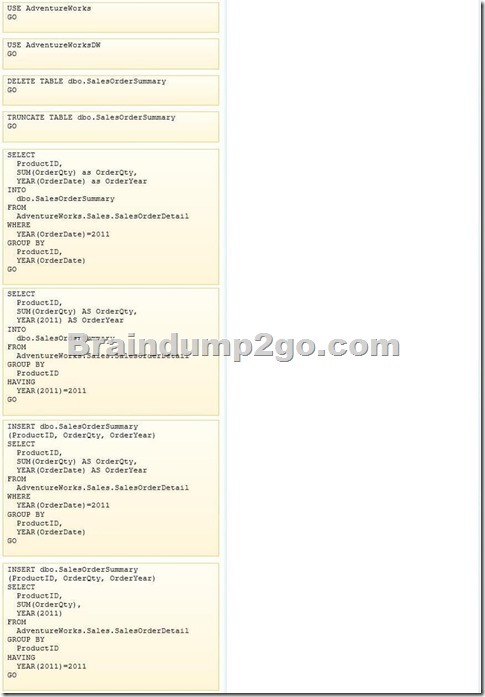
Answer:

QUESTION 175
You administer a Microsoft SQL Server 2008 R2 database that has a table named Customer.
The table has the following definition:

The database also has a table named CustomerExclusionList. Data will be added to the CustomerExclusionList table regularly.
The CustomerExclusionList table has the following definition:

You need to create a view that returns all records and columns of the Customer table that are not present in the CustomerExclusionList table.
Which Transact-SQL statement should you use?

A. Option A
B. Option B
C. Option C
D. Option D
Answer: C
QUESTION 176
You are a database developer writing reports for a sales management application.
A customer table has the following definition:

An order table has the following definition:
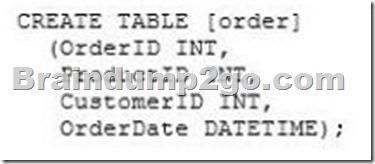
You need to write a report that contains the following columns:
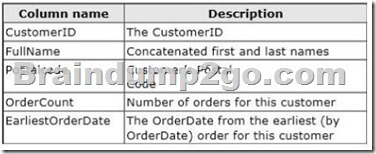
You also need to ensure that the report meets the following requirements:
Which Transact-SQL query should you use?
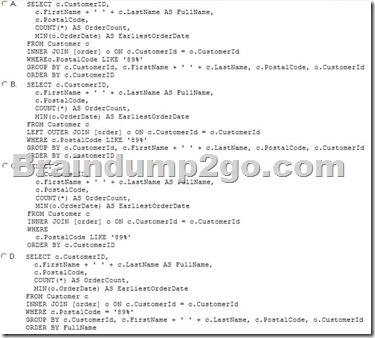
A. Option A
B. Option B
C. Option C
D. Option D
Answer: A
QUESTION 177
A table named Contacts includes a column named SmtpAddress.
You must develop a report that returns e-mail addresses from the Contacts table that have the following format: at least one character, the at sign (@), at least one character, and then “.org”.
You need to return data that meets the requirements.
Which Transact-SQL statement should you use?
A. Select * from Contacts where SmtpAddress like ‘%@%[.]org’
B. Select * from Contacts where SmtpAddress like ‘_%@_%.org’
C. Select * from Contacts where SmtpAddress like ‘_%@_.org’
D. Select * from Contacts where SmtpAddress like ‘%@%.org’
Answer: B
QUESTION 178
You administer a Microsoft SQL Server 2008 database that contains a table named dbo.[order].
There are no triggers on the table.
You plan to create a stored procedure that will have the following parameters:
You need to ensure that the following requirements are met:
Which Transact-SQL statement should you use?
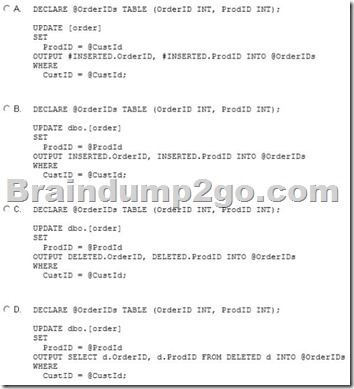
A. Option A
B. Option B
C. Option C
D. Option D
Answer: A
QUESTION 179
You administer a SQL Server 2008 instance.
The instance contains a database table named Sales.SalesOrderDetail.
The table has the following definition:
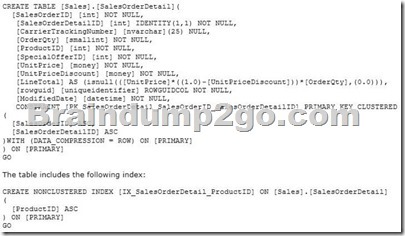
You need to enable row compression for the index.
Which Transact-SQL statement or statements should you use?
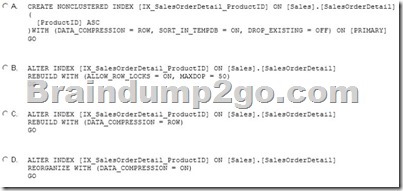
A. Option A
B. Option B
C. Option C
D. Option D
Answer: B
QUESTION 180
Hotspot Question
You administer a Microsoft SQL Server 2008 database that contains two tables named Products and Suppliers.
You want to implement referential integrity between the Products and Suppliers tables.
You want to create a new Foreign Key constraint on the Products table.
The new Foreign Key constraint must meet the following requirements:
You need to be able to create a new Foreign Key constraint by using Microsoft SQL Server Management Studio.
What should you do? (To answer, configure the appropriate option or options in the dialog box in the answer area.)

Answer:
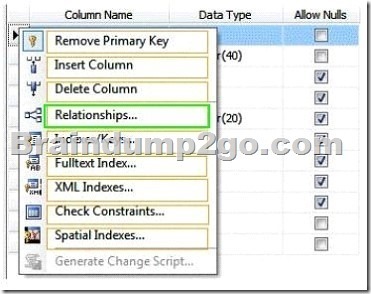
100% Full Money Back Guarantee Promised By Braindump2go to All 70-433 Exam Candiates: Braindump2go is confident that our NEW UPDATED 70-433 Exam Questions and Answers are changed with Microsoft Official Exam Center, If you cannot PASS 70-433 Exam, nevermind, we will return your full money back! Visit Braindump2go exam dumps collection website now and download 70-433 Exam Dumps Instantly Today!






